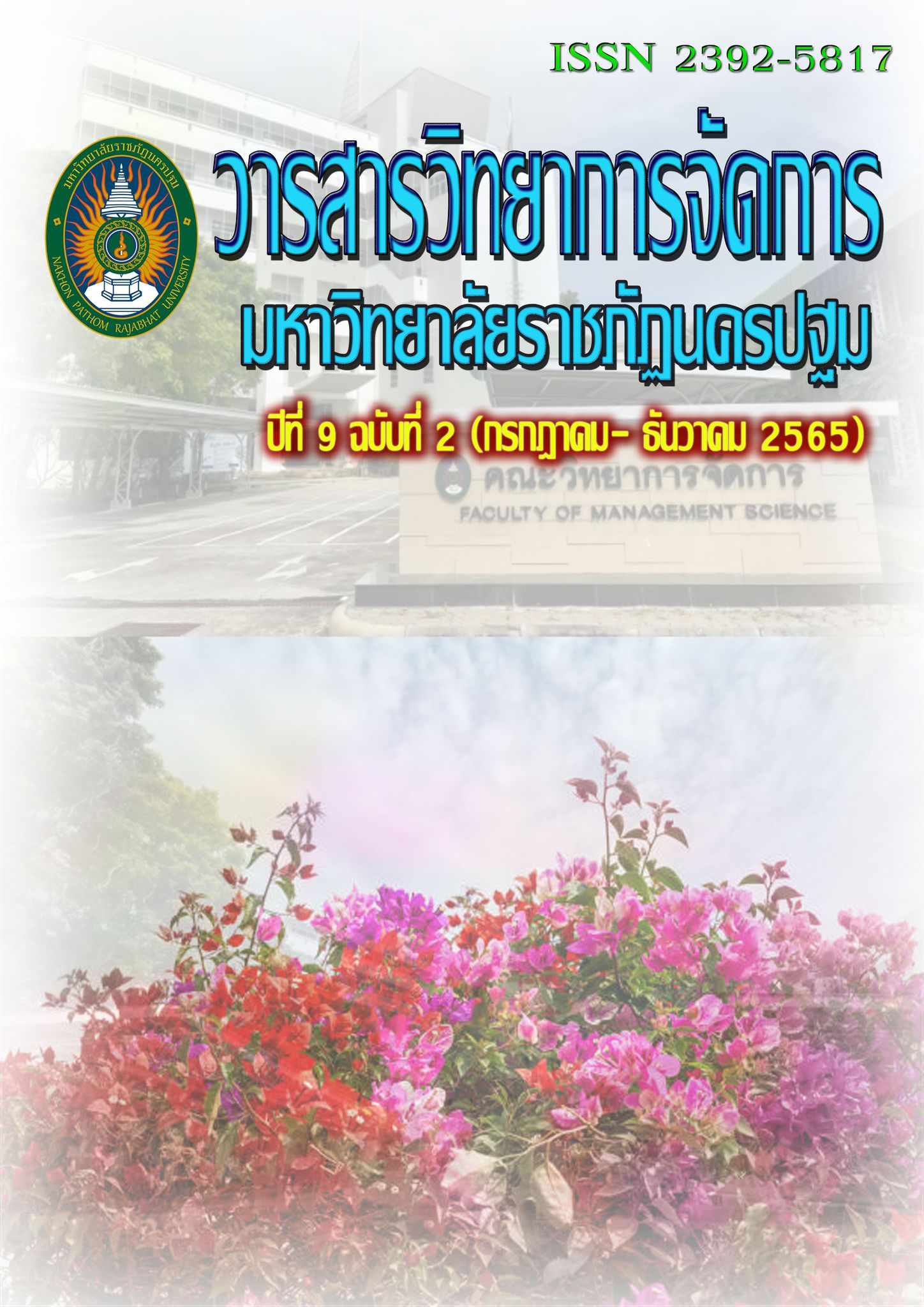ซอฟต์พาวเวอร์ คุณค่าตราสินค้าและพฤติกรรมผู้บริโภคในฐานะตัวแปรคั่นกลางที่เชื่อมโยงการสื่อสารการตลาดแบบบูรณาการสู่การตัดสินใจบริโภคซีรีส์วายในกรุงเทพมหานคร
Main Article Content
บทคัดย่อ
การศึกษาครั้งนี้มีวัตถุประสงค์เพื่อศึกษา 1) ระดับการสื่อสารการตลาดแบบบูรณาการ ซอฟต์พาวเวอร์ คุณค่าตราสินค้า พฤติกรรมผู้บริโภค และการตัดสินใจบริโภค 2) ซอฟต์พาวเวอร์ คุณค่าตราสินค้าและพฤติกรรมผู้บริโภคในฐานะตัวแปรคั่นกลางที่เชื่อมโยงการสื่อสารการตลาดแบบบูรณาการสู่การตัดสินใจบริโภค เครื่องมือที่ใช้ในการวิจัยครั้งนี้ คือ แบบสอบถาม ทำการเก็บข้อมูลกับ ผู้บริโภคซีรีส์วายในกรุงเทพมหานคร จำนวน 500 คน สถิติที่ใช้ในการวิจัยได้แก่ ค่าความถี่ ค่าร้อยละ ค่าเฉลี่ย ส่วนเบี่ยงเบนมาตรฐาน สัมประสิทธิ์การกระจายและวิเคราะห์ตัวแบบสมการโครงสร้าง (SEM) โดยใช้โปรแกรม ADANCO 2.3
ผลการวิจัยพบว่า 1) ระดับการสื่อสารการตลาดแบบบูรณาการ ซอฟต์พาวเวอร์ คุณค่าตราสินค้า พฤติกรรมผู้บริโภค และการตัดสินใจบริโภค อยู่ในระดับมาก มีค่าเฉลี่ยอยู่ที่ 3.77, 3.86, 3.56, 3.89 และ 3.81 ตามลำดับ และส่วนเบี่ยงเบนมาตรฐานอยู่ที่ .716, .706, .866, .837 และ .830 ตามลำดับ 2) ซอฟต์พาวเวอร์ คุณค่าตราสินค้าและพฤติกรรมผู้บริโภคในฐานะตัวแปรคั่นกลางที่เชื่อมโยงการสื่อสารการตลาดแบบบูรณาการสู่การตัดสินใจบริโภค โดยเรียงค่าอิทธิพลรวมประกอบด้วยการสื่อสารการตลาดแบบบูรณาการ (TE=0.713) ซอฟต์พาวเวอร์ (TE=0.438) คุณค่าตราสินค้า (TE=0.284) และพฤติกรรมผู้บริโภค มีอิทธิพลรวมต่อการตัดสินใจบริโภค (TE=0.344) ซึ่งแสดงให้เห็นว่าการสื่อสารการตลาดแบบบูรณาการ ส่งผลต่อการตัดสินใจบริโภคมากกว่า ซอฟต์พาวเวอร์ คุณค่าตราสินค้า และพฤติกรรมผู้บริโภค
* นักวิจัยอิสระ
** อาจารย์ประจำหลักสูตรบริหารธุรกิจมหาบัณฑิต บัณฑิตวิทยาลัย มหาวิทยาลัยเอเชียอาคเนย์ กรุงเทพฯ 10160
Corresponding author: ood_04@hotmail.com
Article Details

อนุญาตภายใต้เงื่อนไข Creative Commons Attribution-NonCommercial-NoDerivatives 4.0 International License.
ทัศนะและข้อคิดเห็นของบทความที่ปรากฏในวารสารฉบับนี้เป็นของผู้เขียนแต่ละท่าน ไม่ถือว่าเป็นทัศนะและความรับผิดชอบของกองบรรณาธิการ
เอกสารอ้างอิง
กรุงศรีเพลินเพลิน. (2564). 5 ซีรีส์ดังที่สร้างมาจากนิยายวาย สุดปัง. [ออนไลน์]. ค้นเมื่อ 22 กุมภาพันธ์ 2565, จาก https://www.krungsri.com/th/plearn-plearn/series-y-from-novel.
ไทยพับลิก้า. (2564). วิกฤติโควิด ดันคนว่างงานทั่วโลกเกิน 200 ล้านคนปี ’65. [ออนไลน์]. ค้นเมื่อ 22 กุมภาพันธ์ 2565, จาก https://thaipublica.org/2021/06/ilo-sees-unemployment-over-200-mln-in-2022/
ไทยรัฐออนไลน์. (2564). จักรวาลจิ้น ซีรีส์วายไทยสุดฟิน ยังไปไกลระดับโลก. [ออนไลน์]. ค้นเมื่อ 22 กุมภาพันธ์ 2565, จาก https://www.thairath.co.th/entertain/news/2239265.
Aaker, D. A. (1996). Measuring brand equity across products and markets. California management review, 38(3), 102-120.
Adaddictth. (2564). IMC การสื่อสารการตลาดแบบบูรณาการที่ใช้ประโยชน์จาก Promotion ใน 7Ps ให้เกิดประโยชน์สูงสุด. [ออนไลน์]. ค้นเมื่อ 22 กุมภาพันธ์ 2565, จาก https://adaddictth.com/kn owledge /IMC-Integrated-Marketing-Communication.
Anani-Bossman, A., & Mudzanani, T. E. (2021). Analysing the Influence of Public Relations in the Integrated Marketing Communication Process. In Marketing Communications in Emerging Economies, Volume I (pp. 105-136). Palgrave Macmillan, Cham.
Altschwager, T., Conduit, J., Bouzdine-Chameeva, T., & Goodman, S. (2017). Branded marketing events: engaging Australian and French wine consumers. Journal of Service Theory and Practice; Managing Service Quality, 27(2), 336-357.
Álvarez-García, J., Cortés-Domínguez, M. D. C., del Río-Rama, M. D. L. C., & Simonetti, B. (2020). Influence of brand equity on the behavioral attitudes of customers: Spanish Tourist Paradores. Quality & Quantity, 54(5), 1401-1427.
Blakeman, R. (2018). Integrated marketing communication: creative strategy from idea to implementation. London: Rowman & Littlefield.
Brand Finance. (2020). Soft Power: why it matters to Governments, People, and Brands. [Online]. Retrieved February 22, 2022, from: https://brandfinance.com/insights/soft-power-why-it-matters.
BTL Bangkok. (2564). ส่องปรากฎการณ์ซีรีส์วาย Soft Power ปลุกเศรษฐกิจไทยกับอภิสิทธิ์ ไล่สัตรูไกล ผู้อำนวยการ CEA. [ออนไลน์]. ค้นเมื่อ 22 กุมภาพันธ์ 2565, จาก https://www.bltbangkok.co m/people/38083/.
Chung, K. Y. (2019). Media as soft power: The role of the South Korean media in North Korea. The Journal of International Communication, 25(1), 137-157.
Comrey, A. L., & Lee, H. B. (1992). Interpretation and Application of Factor Analytic Results. (Eds.). Hillsdale, NJ: Lawrence Eribaum Associates.
Dubinsky, Y. (2019). From soft power to sports diplomacy: A theoretical and conceptual discussion. Place Branding and Public Diplomacy, 15(3), 156-164.
Esmaeilpour, M., & Mohseni, Z. (2019). Effect of Customer Experiences on Consumer Purchase Intention. Romanian Economic Journal, 22(73), 19-38.
Grundey, D. (2009). Eco-marketing and eco-labelling: does it ensure customer loyalty in Lithuania? Transformations in business & economics, 8(1), 152-179.
Henseler, J. (2017). ADANCO 2.0.1: user manual. Kleve: Composite Modeling GmbH & Co.
Hur, W. M., & Kim, Y. (2020). Customer reactions to bank hypocrisy: the moderating role of customer–company identification and brand equity. International Journal of Bank Marketing, 4(2), 1-22.
Islam, H., Jebarajakirthy, C., & Shankar, A. (2021). An experimental based investigation into the effects of website interactivity on customer behavior in on-line purchase context. Journal of Strategic Marketing, 29(2), 117-140.
Kang, S., & Lee, K. H. (2016). A Comparative Study on the Effects of Korean Wave and Corporate Social Responsibility on Chinese Purchase Intention: Western Inland & Eastern Coast of China. e-비즈니스연구, 17(5), 39-52.
Khoa, B. T. (2021). The Impact of Chatbots on the Relationship between Integrated Marketing Communication and Online Purchasing Behavior in The Frontier Market. Jurnal The Messenger, 13(1), 19-32.
Laurie, S., & Mortimer, K. (2019). How to achieve true integration: the impact of integrated marketing communication on the client/agency relationship. Journal of Marketing Management, 35(3-4), 231-252.
Neto, A. R., de Sousa-Filho, J. M., & Lima, A. C. (2021). Internationalization of culture and soft power. European Business Review, 34(1), 103-126.
Nye, J. S. (1990). Soft power. Washington post: Slate Group, LLC.
Nye Jr, J. S. (2008). Public diplomacy and soft power. The annals of the American academy of political and social science, 616(1), 94-109.
Quan, N., Chi, N., Nhung, D., Ngan, N., & Phong, L. (2020). The influence of website brand equity, e-brand experience on e-loyalty: The mediating role of e-satisfaction. Management Science Letters, 10(1), 63-76.
Sawaftah, D. (2020). The Effectiveness of Electronic Integrated Marketing Communications on Customer Purchase Intention of Mobile Service Providers: The mediating role of customer trust. Journal of Sustainable Marketing, 1(1), 33-42.
Seena, M., Tanjul, S., & Neetu, P. (2020). The New Consumer Behaviour Paradigm amid Covid-19: Permanent or Transient. Journal of Health Management, 22(2), 291-301.
Shirvani, S. M., Motamedi, N., & Mohtaram, R. (2020). The effect of country-of-origin on the consumer purchase intention considering the mediating role of the brand equity dimensions. International Journal of Business Information Systems, 35(3), 363-377.
Theodora, N. (2021). Relationship Between Integrated Marketing Communication and Brand Equity. International Journal of Social Science and Business, 5(2), 278-283.
Valášková, K., & Klieštik, T. (2015). Behavioural reactions of consumers to economic recession. Business: Theory and Practice, 16(3), 290-303.
Verma, P. (2021). The effect of brand engagement and brand love upon overall brand equity and purchase intention: A moderated–mediated model. Journal of Promotion Management, 27(1), 103-132.
Zahra, M., Majid, E., & Manijeh, B. (2020). The Effect of Customer Experiences on Purchase Intention Through Mediator Variables of Mental Engagement and Visual Perception. Studies in Business and Economics, 15(2), 175-191.


